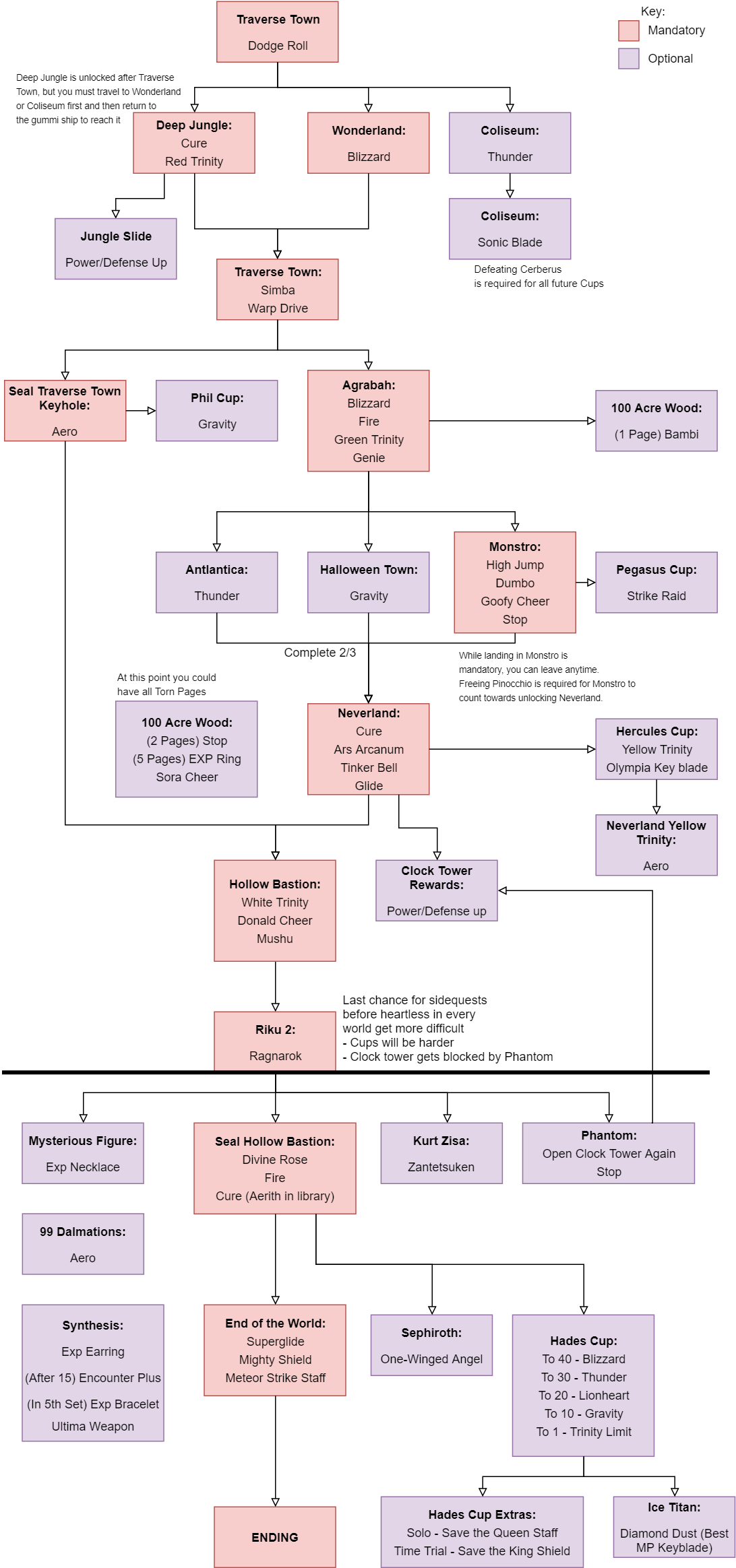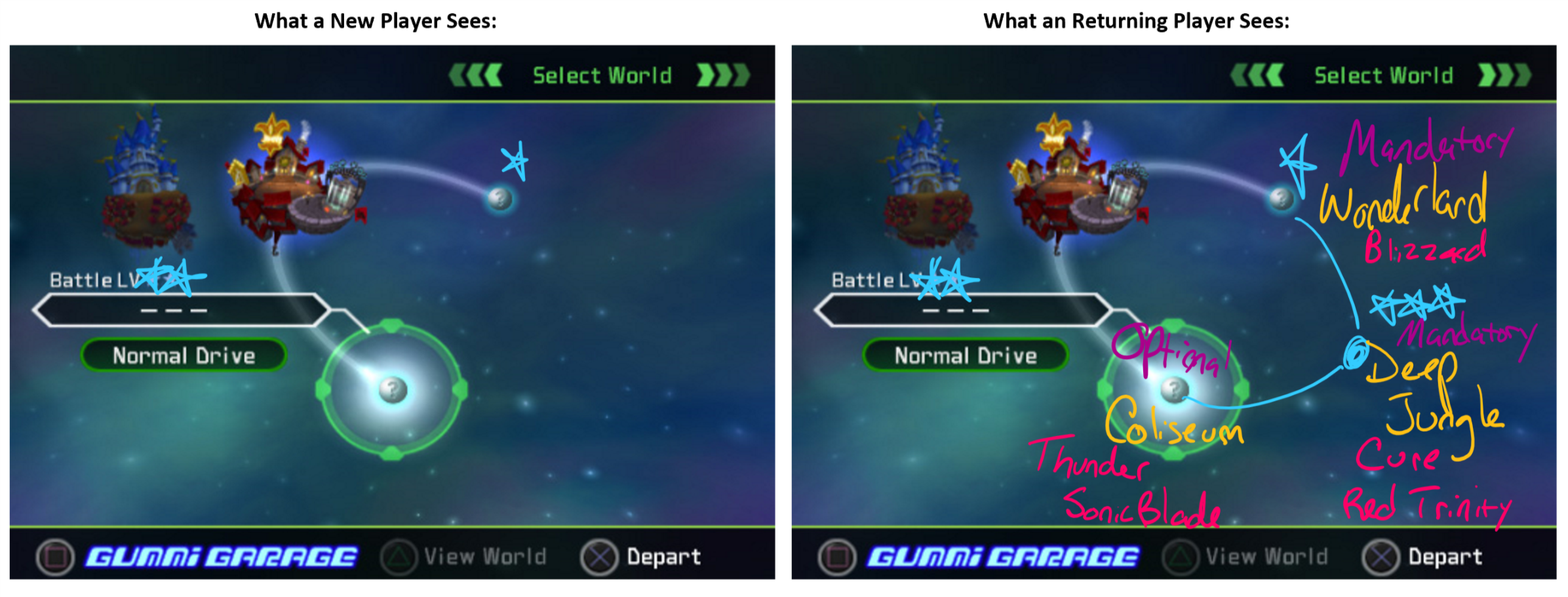Let’s talk about non-linearity of Kingdom Hearts! Here are some different types of non-linearity and where KH fits in them:
- Permanently Branching Storyline/Gameplay – can the player make choices that set them down one path that makes it impossible to see other paths? Very rarely does KH have the player take any paths that block off others.
- Level Design – are levels like hallways or wide open to explore? In KH, it’s certainly not large, open worlds. But, there are things to explore and get lost in – for 2002, definitely a hybrid.
- Quest Design – must the player complete quests in a strict order or can they mix them up? This is what I believe KH does interesting so let’s dive deep.
Does Kingdom Hearts lay out its quests non-linearly? Well, a little bit. There is a central story with 5-6 worlds required in the same order each time you play. In between these, there are a few worlds you can do in whatever order you want. Plus, there are some optional worlds and other optional quests scattered throughout the game. Keeping in mind the game was originally made in 2002 and was one of the first Action RPGs for PS2, I’d say it’s fairly impressive. Kingdom Hearts is an excellent example of a linear game with interesting choices for the player to make along the way.
Here’s a chart I made to show all of the quests and rewards in the game just so you can see the nature of the non-linearity.

What’s great about the non-linearity?
The player can choose the order of quests. Different paths give players a chance to feel like it’s their adventure. They can choose where to explore – a central theme of the game.
There are always side-quests you can do. If a player is struggling or bored in one area, they can always move on to another or do a side-quest to get stronger/variety. Side quests make it easier for low-skilled players to stay in flow due to the variety of content and making gameplay easier if they are struggling in combat.
There are interesting decisions related to the order of doing things. Experienced players that know the rewards can find.
- I can skip Traverse Town boss, but I won’t learn Aero.
- I can skip Olympus, but I won’t learn Thunder.
- Antlantica is slower and can be annoying with 3D movement, but I’ll learn Thundara.
- Speedrunners can decide to skip the coliseum entirely.
- A level 1 speed run can decide to go get Thunder/Cure before Wonderland.
- 100% playthroughs can decide when to do 100-Acre Wood to get Sora’s Cheer, Exp Ring, and Stop.
What could be better?
Notice the chart above? Every single reward in the chart is hidden from the player’s view. In order to know the rewards, you must explore the game yourself or look it up. In order to make a decision interesting, you must know the risks and rewards of each option.
Limited information reduces how interesting decisions are. Imagine if the reward of a cup in the Coliseum was shown before entering the cup. You could decide if a cup is worth it or not before attempting it. This is why experienced players have a plethora of decisions to make with so many routes through the game. They know exactly what they could get, so they go out of their way to get it.
Here’s an example of information presented in the first world selection choice through the eyes of a new player and a player that knows everything:

Returning players that know all the info can make several decisions here. Speedrunners skip Coliseum completely and never learn Thunder. Level 1 players order: Coliseum (just get Thunder) > Deep Jungle for Cure > Wonderland.
Why is so much information hidden?
- The theme of exploration – they want players to be surprised by the worlds they see and the rewards they receive.
- To simplify – don’t overwhelm the player with too much information, especially that which would be hard to understand. Especially important because this game caters to kids.
- Buy the strategy guide! (This was before prevalent internet, after all.)
- Development effort
As we can see, there are pros and cons of showing information. While I personally would like more info, I think the developers made the right decision to keep in line with their theme and focus towards a younger audience. Game designers out there: consider your balance of information appropriately. Here, they decided the only relevant info to show new players was the difficulty of the world they were about to visit to attempt to keep them from being frustrated with difficulty unexpectedly.
Avoiding pitfalls of non-linearity
Pitfall 1: Story segmentation. The more non-linear the story the harder it is to write a cohesive narrative. Additionally, being able to see things out of order requires remembering/implementing all the little pieces that could change should the player take a different path.
Kingdom Hearts works well with this because the Disney world stories are naturally segmented from each other that allows for the order to change. Not many things in each world depend on other worlds. Only a few scenes change. For example: after Deep Jungle, in a scene with the villains, Alice is replaced by Snow White if she hasn’t been captured yet and seeing Riku in Monstro is different if you go to Hollow Bastion first.
The other way they mitigate story segmentation is keeping some worlds or sections of the game devoted to the main story. It alternates between mandatory segments and sections where you can choose your order. I like this compromise.
Pitfall 2: Balancing Gameplay. How can players stay in flow even if they go out of order? They may have chosen to make it more difficult for themselves, but if it’s impossible to survive, they will still get frustrated. Likewise, if players do lower leveled content at higher levels, it may get boring. How does KH attempt to avoid this?
- Battles focus on action over strategy so high-skilled players are able to use their timing reflexes to be able to defeat enemies higher-leveled than they are.
- Limit how many worlds can be done at a time. Major sections of non-linearity only allow 3 worlds out of order. So during the main story, you can only be at max a few levels off of the expected level.
- Focus on a variety of content types to keep players from getting bored.
- The difficulty of worlds is shown before traveling to a new world – new players don’t accidentally do content more difficult than they expect.
- Freedom to go in and out of worlds most of the time – if a player gets stuck, they can do another challenge instead.